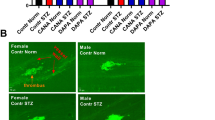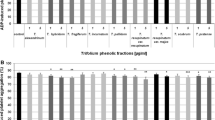Abstract
Multiple blood cell types and metabolic pathways involved in the modulation of platelet reactivity were investigated in streptozotocin-induced diabetic rats treated with garlic oil. Platelet counts of diabetic rats treated with garlic oil were significantly (P<0.01) reduced as compared to diabetic control rats. Garlic oil also increased the leucocyte counts of diabetic rats as compared to diabetic control rats. The significant (P<0.001) decreases by garlic oil of plasma concentration factors, V, VII, VIII: C, IX and X in diabetic rats may be interpreted to mean that there was a modulation of factor VII similar to that brought about by thrombin on factors V and VIII: C. This reversal of hypercoagulation through integrated biochemical reaction is suggestive of multicellular modulation of platelet reactivity, erythrocytes and neutrophils and the functional interactions between plasma coagulation factors and platelet cofactors.


Similar content being viewed by others
References
Adoga GI, Ohaeri OC (1991) Effects of garlic oil on prothrombin, thrombin and partial thromboplastin times in streptozotocin-induced diabetic rats. Med Sci Res 19:407–408
Broze GJ Jr (1995) Tissue factor pathway inhibitor and the current concept of coagulation. Blood Coagul Fibrinolysis 6:S7–S12
Brozovic M, Mackie I (1991) Investigation of acute haemostatic failure. In: Dacie JV, Lewis SM (eds) Practical haematology 7th edn. Churchill Livingstone, London, pp 281–282
Ceriello A, Giugliano D, Quatraro A, Dello Russo P, Torella R (1988) Blood glucose may condition FVII levels in diabetic and normal subjects. Diabetilogia 31:889–891
Ceriello A,Giacomello R, Colatutto A, Taboga C, Gonano F (1995) Hyperglycaemia induced thrombin formation in diabetes: the possible role of oxidative stress. Diabetes 44:924–928
Dacie JV and Lewis SM (1991) Basic haematological techniques. Diabetes 44:924–928
Gerstein HC, Yusuf S (1996) Dysglycaemia and risk of cardiovascular disease. Lancet 347:949–950
Kannel WB, D’Agostino RB, Wilson PW, Belanger AJ, Gagnon DR (1990) Diabetes, Fibrinogen, and risk of cardiovascular disease: the Framingham experince. Am Heart J 120:672–676
Kwaan HC (1992) Changes in blood coagulation, platelet function, and plasminogen-plasmin system in diabetes. Diabetes 41(Suppl. 2):32–35
Laasko M, Lehto S (1997) Epidemiology of macrovascular disease in diabetes. Diabetes Rev 5:294–315
Makheja AN, Bailey JM (1990) Antiplatelet constituent of garlic and onion. Agents Act 29:360–363
Marcus AJ (1990) Thrombosis and inflammation as multicellular processes. Pathophysiolological significance of transcellular metabolism. Blood 76:1903–1907
Marcus AJ, Safier LB (1993) Thromboregulation: multicellular modulation of platelet reactivity in haemostasis and thrombosis. Fed Am Soc Exp Biol J 7(6):516–522
Miller GJ, Stirling Y, Esnouf MP, Heinrich J, van de Loo J, Kienast J, Wu KK, Morrissey JH, Meade TW, Martin JC (1994) FVII-deficient substrate plasmas depleted of protein C raise the sensitivity of the FVII bio-assay to activated FVII: an international study. Thromb Haemost 71:38–48
Morrissey JH, Macik BG, Neuenschwander PF, Comp PC (1993) Quantitation of activated FVII levels in plasma using a tissue factor mutant selectivity deficient in promoting FVII activation. Blood 81:743–744
Muntean WE, Borkenstein MH, Haas J (1985) Elevation of FVIII over FVIII coagulant antigen in diabetic children without vascular disease: a sign of activation of the FVIII coagulant moiety during poor diabetes control. Diabetes 34:140–144
Nemerson Y (1992) Tissue factor pathway of blood coagulation. Semin Haematol 2:170–176
Ohaeri OC (1999) Renal function and calcium metabolism in streptozotocin-diabetic rats treated with garlic oil. Med Sci Res 27:443–444
Ohaeri OC (2001) Effect of garlic oil on the levels of various enzymes in the serum and tissue of streptozotocin diabetic rats. Biosci Rep 21(1):19–24
Osterman H, van de Loo J (1986) Factors of the hemostatic system in diabetic patients. Haemostasis 16:386–416
Rapaport SI, Rao LVM (1995) The tissue factor pathway: how it has become a “prima ballerina”. Thromb Haemost 74:7–17
Acknowledgment
The author acknowledges the financial contribution of the Federal Ministry of Health and Social Welfare Nigeria to O.C. O haeri. The data in this paper formed part of a PhD thesis submitted to the University of Jos, Nigeria. We are grateful to Professor Z.S.C. Okoye for useful comments and advice.
Author information
Authors and Affiliations
Corresponding author
Rights and permissions
About this article
Cite this article
Ohaeri, O., Adoga, G. Anticoagulant Modulation of Blood Cells and Platelet Reactivity by Garlic Oil in Experimental Diabetes Mellitus. Biosci Rep 26, 1–6 (2006). https://doi.org/10.1007/s10540-006-9004-1
Published:
Issue Date:
DOI: https://doi.org/10.1007/s10540-006-9004-1




